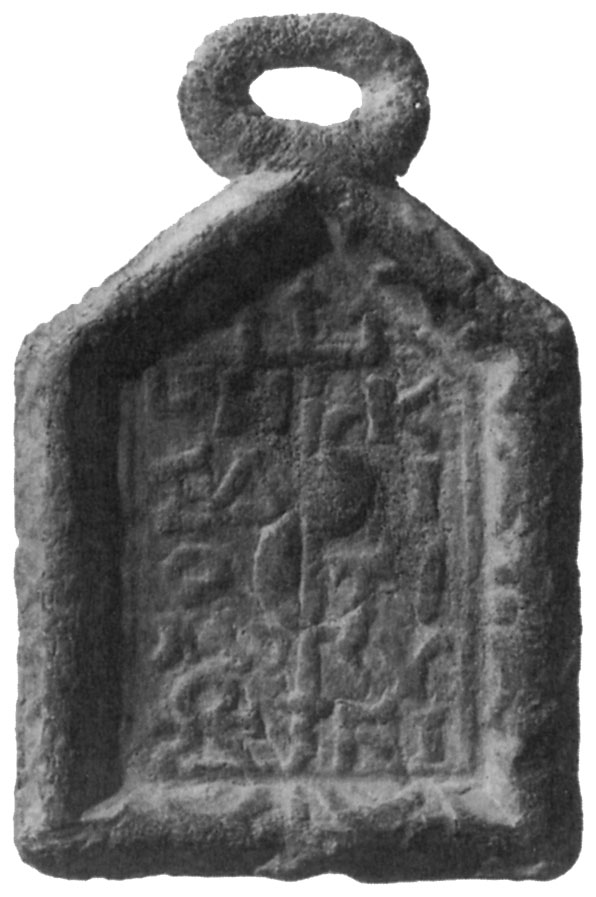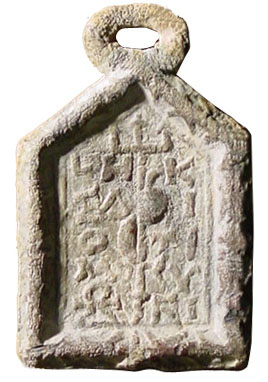
-
Copyright credit: Kushnir-Stein 2002

-
Copyright credit: Kushnir-Stein 2002

-
Copyright credit: Auction Archaeological Center 2007

-
Copyright credit: Auction Archaeological Center 2007

ARCHAEOLOGICAL DESCRIPTION OF THE WEIGHT
Authority
Diotimos, agoranomos (Berytos)
Mint
Berytos
Denomination
1/16 Mina
Material
Lead
Manufacture
Cast
Shape
Polygon (pentagon, hexagon, heptagon, octagon, etc.)
Length
3.35 cm
Width
5.50 cm
Height
0.45 cm
Metrology
| Mass (g) | Mass (grain) | Date of measurement | Reference | fragmented | cleaned | reference weight |
|---|---|---|---|---|---|---|
| 36.40 | - | - | Auction Archaeological Center 2007 | No | No | Yes |
| 36.44 | - | - | Kushnir-Stein 2002 | No | No | No |
Iconography
| Symbol | Technique | Direction | Position | Number | Synecdoche |
|---|---|---|---|---|---|
| Dolphin | Relief | ||||
| Trident | Relief | ||||
| Sign of Tanit | Relief | ||||
| Lattice pattern | Relief | ||||
| Egg and dart pattern | Relief |
Wear
Corrosion
Handle
Yes
Suspension hole
Yes
Recarved mould
No
Recarved weight
No
Intentionally destroyed
No
Archaeological description
Auction Archaeological Center 2007: Phoenicia, Berytus (Beirut). A Hellenistic Period non-regular pentagon lead weight with a hanging loop and a raised and striped border, 36.4 gr., 5.5×3.35 cm., 0.45 cm. thick. The center depicts a dolphin entwined around a trident, with the symbol of the Punic goddess Tanit at the lower left corner. The Greek inscription reads: LΗΚ/Σ ΔΙ/ΟΤΙ/ΜΟΥ “Year 228 (under the supervision) of Diotimos”. Year 228 according to the Seleucid era of 312 is equal to 85/4 BC. Two characters at the lower right corner are of unclear meaning. The reverse has a network pattern. Good condition. Rare. For a similar weight from Berytus depicting the trident (Beirut Museum, inv. No. 4769), see: Liban, l’autre rive, p.162. (A. Spaer coll. no. W-111 ). Published by Alla Kushnir-Stein, 2002, no. 3.
Kushnir-Stein 2002: This is a rectangular lead weight with a loop at its top; the upper part below the loop is triangular. The weight's length (without the loop) is 4.5 cm.; the diameter of the loop is 0.5 cm. The weight is 3.35 cm. wide, 0.45 cm. thick and weighs 36.44 gm. Its reverse has a network pattern. The side with the inscription has a raised border with a decoration of semi-circles on the side facing the inscription; the outer bevelled side of the border is decorated by a network pattern. In the centre of the obverse there is a dolphin entwined around a trident. The inscription in four lines on both sides of the trident reads: LΗΚ|Σ ΔΙ|ΟΤΙ|ΜΟΥ, 'Year 228, (under the supervision) of Diotimos'. On the left side under the fourth line there is the symbol of Tanit; on the right there are two letters.
Kushnir-Stein 2002: This is a rectangular lead weight with a loop at its top; the upper part below the loop is triangular. The weight's length (without the loop) is 4.5 cm.; the diameter of the loop is 0.5 cm. The weight is 3.35 cm. wide, 0.45 cm. thick and weighs 36.44 gm. Its reverse has a network pattern. The side with the inscription has a raised border with a decoration of semi-circles on the side facing the inscription; the outer bevelled side of the border is decorated by a network pattern. In the centre of the obverse there is a dolphin entwined around a trident. The inscription in four lines on both sides of the trident reads: LΗΚ|Σ ΔΙ|ΟΤΙ|ΜΟΥ, 'Year 228, (under the supervision) of Diotimos'. On the left side under the fourth line there is the symbol of Tanit; on the right there are two letters.
Autopsy
No
INSCRIPTION
| Language | Technique | Legend type |
|---|---|---|
| Greek | Relief | Authority, Date, Denomination |
Fac simile
LΗΚ
Σ ΔΙ
ΟΤΙ
ΜΟΥ
{Sign of Tanit} ϜI
Edition
(Ἔτους) ηκ|σ´ Δι|οτί|μου | {Sign of Tanit} ϝι’
Finkielsztejn: ϝι’ (=16?) [rather than ηι’ (=18)? or 3 signs; Phoenician?]
Finkielsztejn: ϝι’ (=16?) [rather than ηι’ (=18)? or 3 signs; Phoenician?]
Monogram
ARCHAEOLOGICAL CONTEXT
Findspot (region)
Findspot (site)
context
CIRCUMSTANCES OF ACQUISITION
Region
City
Date of first acquisition
April 4, 2007
circumstances
Antiquities trade.
DATING OF THE WEIGHT
Curatorial Section
GREEK
Time frame
FROM
-85
TO
-84
Comments on Chronology
SE 228 = 85/84 BCE
COLLECTION HISTORY
Collection
| Name | Date of acquisition | Inventory number |
|---|---|---|
| Antiquities Trade | April 4, 2007 | None |
| Spaer Collection | None | W-111 |
Bibliography
| Reference | Page/Column | Reference (number) | Plate / Figure | Comment |
|---|---|---|---|---|
| Kushnir-Stein 2002a | 227–228 | 3 | fig. 3 | None |
| SEG 52 | None | 1568 | None | (non vidi) |
| BÉ 2003 | 666 | 571 | None | None |
| Kushnir-Stein 2005 | 18* | None | None | None |
| SEG 55 | None | 1629, 4 | None | (non vidi) |
| Auction Archaeological Center 2007b | 15–16 | 412 | fig. 412 | None |
| Finkielsztejn 2012 | 142 | 32 | None | None |
| Gatier 2014 | 153–154 | None | None | None |
| Finkielsztejn 2015 | 80–82 | 124 | pl. 4/124 | None |
| IGLS VIII/1 | None | None | None | None |
VARIA
Additional comment
Kushnir-Stein 2002: The meaning of the letters in the lower right field is unclear. On the weight of Berytus dated year 184 (129/8 BCE; 55.8 gm.) there is a letter M standing alone in the right field (Rouvier 1897: 369-372). This letter has been interpreted as an indication of weight. However, on the weight of year 161 (152/1 BCE; 267 .8 gm.; Babelon and Blanchet 1895: no. 2250) one finds the letters MZ, which seem difficult to reconcile with this interpretation. These letters, as well as those on our weight, may thus have related to administrative matters rather than to the units of weight.
Kushnir-Stein 2005: On yet another weight from Berytus, from the year 85/4 BCE (Kushnir-Stein 2002: 227-228), the inscription ends with the letters {blank}. The first letter is similar to one of the forms of the digamma (6), while the second, if one ignores the short line above the vertical bar, may be understood as iota (10). The number, then, would be 16; the line above the iota would, as in the previous case, indicate that this part of the inscription is a number. The item weighs 36.44 g, which is indeed equivalent to 1/16 of the Seleucid mina.
Kushnir-Stein 2005: On yet another weight from Berytus, from the year 85/4 BCE (Kushnir-Stein 2002: 227-228), the inscription ends with the letters {blank}. The first letter is similar to one of the forms of the digamma (6), while the second, if one ignores the short line above the vertical bar, may be understood as iota (10). The number, then, would be 16; the line above the iota would, as in the previous case, indicate that this part of the inscription is a number. The item weighs 36.44 g, which is indeed equivalent to 1/16 of the Seleucid mina.
Permalink
External link